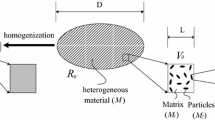Abstract
Considering a semi-infinite planar crack propagating along a plane where the local toughness is a random field, the addressed problem is to compute the effective (or homogeneous and macroscopic) toughness. After a brief introduction to the two regimes—strong and weak pinning—that are expected depending on the system size, a self-consistent homogenization scheme is introduced. It is shown that this scheme allows one to predict not only the mean value but also the standard deviation and even the complete probability distribution function of the toughness. A discussion about the quality of this prediction as compared with direct numerical simulations is proposed.
Similar content being viewed by others
References
Bonamy D, Ponson L, Prades S, Bouchaud E, Guillot C (2006) Scaling exponents for fracture surfaces in homogeneous glass and glassy ceramics. Phys Rev Lett 97(13): 135504
Bornert M, Bretheau T, Gilormini P (eds) (2008) Homogenization in mechanics of materials. Lavoisier, Paris (France)
Bouchaud JP, Bouchaud E, Lapasset G, Planes J (1993) Models of fractal cracks. Phys Rev Lett 71(14): 2240–2243
Charles Y, Vandembroucq D, Hild F, Roux S (2004) Material-independent crack arrest statistics. J Mech Phys Sol 52(7): 1651–1669
Charles Y, Vandembroucq D, Hild F, Roux S (2006) Materials-independent crack arrest statistics: application to indentation experiments. Int J Fract 142(1–2): 51–67
Delaplace A, Schmittbuhl J, Måløy KJ (1999) High resolution description of a crack front in a heterogeneous Plexiglas block. Phys Rev E 60(2): 1337–1343
Ertas D, Kardar M (1994) Anisotropic scaling in depinning of a flux line. Phys Rev Lett 73(12): 1703–1706
Fisher DS (1985) Sliding charge-density waves as a dynamic critical phenomenon. Phys Rev B 31(3): 1396–1427
Gao H, Rice JR (1989) First-order perturbation analysis of crack trapping by arrays of obstacles. ASME J Appl Mech 56: 828–836
Hansen A, Hinrichsen EL, Roux S (1991) Scale-invariant disorder in fracture and related breakdown phenomena. Phys Rev B 43: 665–678
Hill R (1965) A self-consistent mechanics of composite materials. J Mech Phys Solids 13: 213–222
Kardar M, Parisi G, Zhang YC (1986) Dynamic scaling of growing interfaces. Phys Rev Lett 56(9): 889–892
Lawn BR (1993) Fracture of brittle solids. Cambridge University Press, Cambridge (UK)
Morrissey JW, Rice JR (2000) Perturbative simulations of crack front waves. J Mech Phys Solids 48(6–7): 1229–1251
Perrin G, Rice JR (1994) Disordering of a dynamic planar crack front in a model elastic medium of randomly variable toughness. J Mech Phys Sol 42(6): 1047–1064
Ramanathan S, Fisher DS (1998) Onset of propagation of planar cracks in heterogeneous media. Phys Rev B 58(10): 6026–6046
Roux S, Vandembroucq D, Hild F (2003) Effective toughness of heterogeneous brittle materials. Eur J Mech A/Solids 22: 743–749
Sanchez-Palencia, E, Zaoui, A (eds) (1987) Homogenization techniques for composite media, Lecture Notes in Physics, vol 272. Springer, Berlin (Germany)
Schmittbuhl J, Måløy KJ (1997) Direct observation of a self-affine crack propagation. Phys Rev Lett 78(20): 3888–3891
Schmittbuhl J, Roux S, Vilotte JP, Måløy KJ (1995) Interfacial crack pinning: effect of nonlocal interactions. Phys Rev Lett 74(10): 1787–1790
Tanguy A, Gounelle M, Roux S (1998) From individual to collective pinning: effect of long-range elastic interactions. Phys Rev E 58(2): 1577–1590
Vandembroucq D, Skoe R, Roux S (2004) Universal depinning force fluctuations of an elastic line: application to finite temperature behavior. Phys Rev E 70(5): 051101
Author information
Authors and Affiliations
Corresponding author
Rights and permissions
About this article
Cite this article
Roux, S., Hild, F. Self-consistent scheme for toughness homogenization. Int J Fract 154, 159–166 (2008). https://doi.org/10.1007/s10704-008-9271-x
Received:
Accepted:
Published:
Issue Date:
DOI: https://doi.org/10.1007/s10704-008-9271-x




